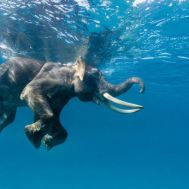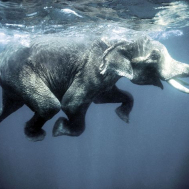Take a moment this weekend to see how much YOU know about elephants! This fun, interactive quiz is great for the whole family. Let us know what your score is - Elephantopia scored PLATINUM! That’s because we LOVE ELEPHANTS and are passionate about sharing that love through education. Together, we can create a harmonious future for elephants and humans!
Elephantopia
A Harmonious Future for Elephants & Humans
Category Archives: Q&A
Q&A
Q&A for Earth Day: Earth Week

Q&A
- The African elephant has ears that average at least three times the size of the Asian elephant
- Ears are used to regulate body temperature. Temperature control is a constant issue because the elephant has a low surface-to-volume ratio. Despite the elephant’s low metabolic rate, it is difficult to lose heat through radiation because of the ear’s small surface area compared to the total volume of an elephant. With the wide surface area of the outer ear tissue, hot blood in the arteries is cooled as it is filtered through the vast network of capillaries and veins. The cooled blood is then returned to the blood stream. It is easier for the African elephant to cool itself with it’s ears than the Asian.
- Ears are used as signaling organs: as a protective feature to ward off potential threats. By spreading the ears wide, this produces a intimidating frontal area to predators like lions and humans.
- Each elephant’s ear is unique and is used as a a type of fingerprint for identification
- The physical make-up of the ear is a cartilaginous sheet to relatively thin skin is closely attached. It is very soft and sensitive.
- The elephant ear has infrasound capabilities for long range communication.
Check out these magnificent ele-ears!
Learn more about Elephants by visiting This Page.
Q&A

Packy, the oldest male Asian elephant in North America, turns 51 this week at the Oregon Zoo. Visitors can wish him a happy birthday during the zoo’s Elephantastic celebration, April 14.
QUESTION from Concerned Mother in Houston:
I recently took my son to the zoo and he was very depressed when we saw the elephants. He didn’t understand why such large animals are in zoos. Now he wants to grow up and help elephants get out of zoos. My question is, why are elephants in the zoo to begin with?
ANSWER:
It is troublesome to see such large animals in captivity. And there are many groups who would like to see elephants only in the wild and not at zoos. However, zoos play an important role in education and raising public awareness. First off, your son wants to work with elephants, mainly in part because of his experience at the zoo. If he had not been exposed to these amazing animals at the zoo, there is a chance he would not be interested in them. I know from first-hand experience myself that my love for elephants is directly related to the zoo. When I was six, I went “behind the scenes” at the Memphis Zoo and fed an elephant. That experience alone engendered me to these magnificent animals.
Zoos that are affiliated with the AZA (Association of Zoos and Aquariums) are required to meet certain guidelines for animal care. These zoos are also required to provide animal enrichment opportunities, which help keep the animals active and happy. So before visiting a zoo, check to see if they are accredited. Currently, there are 221 listed with the AZA. This will assure you of the highest, most advanced quality of care for the elephants, and all animals there.
This weekend, one of the most prestigious zoos in North America for elephant care, the Oregon Zoo, is celebrating a very special pachyderm birthday. Packy the elephant is turning 51 and has been instrumental for teaching people about Asian Elephants. As one Zoo volunteer said, “People only protect what they know…and this all a wonderful chance to get to know about Asian Elephants.” Packy is “the largest, oldest Asian bull elephant in North America, and he has ushered in a new and better understanding of these magnificent pachyderms.”
So are zoos ideal? No. In a perfect world, all animals would be living in the wild. We hope that maybe someday there won’t be a need for zoos. But until then, zoos do play an instrumental role in raising public awareness and helping with species survival. Below is a 5 minute video from the Oregon Zoo from last year’s birthday party for Packy.
Q&A
We received some emails with various questions about elephants. Maybe you have some too. We are going to begin to answer these questions every Thursday. Send us a note with yours and you can be featured here too!
QUESTION from Anonymous:
Is China solely responsible for the ivory trade issue, or is there something we need to change here in the States to help?
ANSWER:
(details from NYTimes and Washington Post articles)
The Union for Conservation of Nature estimates that the illegal ivory trade is now three times as large as it was in 1998. And seizures of illegal ivory shipments over one ton (or 800 kg) in size have doubled since 2009. A 2011 study from CITES monitored 60 of the locations most-frequented by elephants. They found that an astounding 7.4 percent of those elephants were killed illegally just that year. On those sites, which account for about 40 percent of the entire African population, they estimated that 17,000 elephants were killed.
One wonders, where is all this ivory going? Most of it comes from Africa and ships to countries in Asia. The countries involved in this illegal trade are often called the “Gang of Eight”: the exporters Kenya, Tanzania and Uganda; middleman states Vietnam, Malaysia and the Philippines; and consumers China and Thailand.
“The Chinese hold the key to the elephants’ future,” said Iain Douglas-Hamilton, founder of Save the Elephants. “If things continue the way they are, many countries could lose their elephants altogether.”
And since the beginning of 2012, more than 32,000 elephants have been illegally killed, claims the Born Free Foundation, a wildlife organization. Conservationists say the majority of ivory is sold to China, where it sells for more than $1,300 a pound on the black market.
“China is clearly driving the illegal ivory trade more than any other nation on earth,” said Tom Milliken, an elephant expert with the wildlife trade-monitoring network Traffic.
It would be easy to solely blame China. And evidence does show that much of the ivory trade is based on Asian consumption. However, China is not alone in it’s transgressions. In America, and other countries where the issue of ivory seems irrelevant and almost non-existent, we participate in the ivory trade through apathy. Most people don’t realize that elephants will be extinct in some parts of Africa by 2020. And when we do learn about it, nothing is done. Apathy, the lack of concern and indifference, is just as bad as poaching. America, through apathy, should be listed with the “Gang of Eight” because standing by and idly watching while an entire species is destroyed carries the same amount of bloodshed as poaching. (Check out this latest blog post on apathy, the greatest threat to elephants, for more details).
So please, take a moment and do something about this. SHARE THIS BLOG with people who may not know about the the elephant crisis. SIGN THIS PETITION and then get your friends to as well.
 (Map cartographer/designer Riccardo Pravettoni, GRID-Arendal, reposted from http://www.grida.no/graphicslib/detail/large-scale-ivory-seizures_6732)%5B/caption%5D
(Map cartographer/designer Riccardo Pravettoni, GRID-Arendal, reposted from http://www.grida.no/graphicslib/detail/large-scale-ivory-seizures_6732)%5B/caption%5D





